

Wild or cultivated purslane is a crawling plant that has leaves that are appreciated for their light lemony taste.
A summary of purslane facts
Name – Portulaca oleracea
Family – Portulacaceae
Type – annual, crawling
Height – 4 to 8 inches (10 to 15 cm)
Exposure – full sun
Soil – ordinary, well drained
Flowering – June to October
Harvest – 2 months after sowing
Low-calorie content makes it great for salad or cooked like spinach leaves are. And it’s healthy, too!
Purslane (a type of rose moss) mostly grows around the Mediterranean ocean and loves heat to truly develop well.
Although it grows naturally in the wild, one can also sow purslane in the vegetable patch.
Sow preferably in spring or summer in a full sun spot.
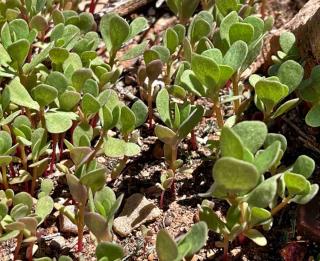 Sowing is from March to September.
Sowing is from March to September.Tip: If you stage your sowing in time, you’ll also stage your purslane harvests in the vegetable patch.
If you’ve purchased your garden purslane in nursery pots, you can transplant them from March to September.
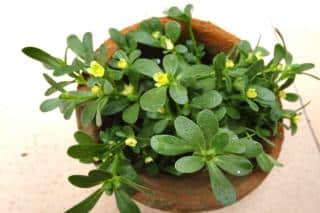 Purslane will grow very well in a pot. Its succulent-like leaves make it highly resistant to drought, so it doesn’t need daily watering like other potted plants.
Purslane will grow very well in a pot. Its succulent-like leaves make it highly resistant to drought, so it doesn’t need daily watering like other potted plants.
Important: prepare the pot in such a way that it has great drainage:
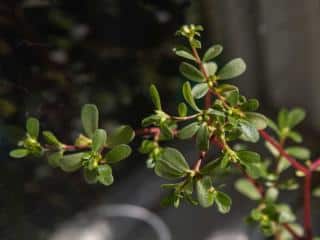 Purslane requires very little work and care, which makes it an easy plant to grow.
Purslane requires very little work and care, which makes it an easy plant to grow.
Running the hoe against weeds around the plant are about the only work you’ll have to provide.
Purslane re-seeds spontaneously, and a single plant can be harvested up to 3 times during the year.
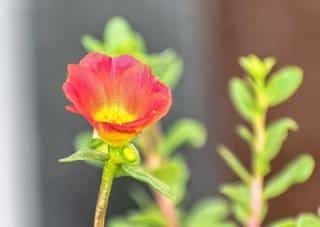 You can start to harvest purslane more or less 2 months after sowing, or a bit later depending on the growing conditions and the climate.
You can start to harvest purslane more or less 2 months after sowing, or a bit later depending on the growing conditions and the climate.
Purslane is a plant that doesn’t keep fresh for very long, since it doesn’t hold well to freezing.
But it can easily be kept for 2 or 3 days in the refrigerator, in the vegetable compartment, wrapped in paper tissue.
Also, it is possible to pickle purslane in jars with vinegar and thus keep it for several months.
Sometimes considered a weed, this cute annual plant that crawls along and spreads out offers delicious edible leaves.
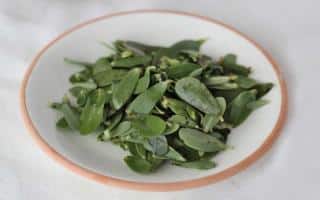 A staple item of the Cretan diet, purslane is both low in calories and excellent to prevent risks of cardiovascular diseases.
A staple item of the Cretan diet, purslane is both low in calories and excellent to prevent risks of cardiovascular diseases.
In it, you’ll find potassium, calcium, magnesium, vitamins C and B, iron and also omega-3 and β-carotene, which are definitely part of any diet that aims to prevent many diseases. In short, purslane is loaded with health benefits!
It is cooked a bit like spinach, since it can be eaten raw in mixed salads, or cooked or in soups.
If you wish, a simple way to cook your purslane is to heat up a dollop of butter in a pan, throw in the purslane and fry for about 3 minutes.
If properly settled in, no need to water anymore, even in hot weather, since this plant tolerates drought very well.
We put weed killer on last years purslane so will this years be safe to eat
I have come to love Purslane and always looking for it to add to my food and Salads each day. I love to read about plants, especially Purslane which wet my appetite to hunt for it more and more even when I travel and also encourage people in making the plant one of the best in their diet.
Especially for students, due to omega 3 and other nutritional benefits. The Creator is most wonderful in His dealings. Great is thy faithfulness… New mercies abound.
May the bounty and harmony of nature bring peace among us all! Nice to know you like this special “greens”, too!
I bought one of these Purslane plants from Lowes about a month ago while it was bloom. I transplanted into a pot and placed in a sunny spot on my porch. I follow directions enclosed to water 2x a week but it died. I wasn’t sure if it was the 115+ degrees we’ve been having in Bullhead Arizona or what.
If, as it died, leaves rather dried up and withered, it’s due to lack of water. Especially when transplanting, roots haven’t yet reached most of the pot, it takes time for them to grow out. If that’s the case, in hot weather, simply having watered “further off” from the stems means perhaps the root-filled portion wasn’t watered.
If, on the other hand, it turned yellow and limp before dying, then perhaps your soil mix retains water too well, or there isn’t any hole at the bottom of the pot and water accumulates to drown the plant.
Oh my gosh.
I have been pulling these in my garden as I thought they were weeds.
Pretty red and green.
Actually bought two yesterday at Lowes. Different color
Then I looked the name up. Holy Molely, I have hundreds .
Well I guess I stop pulling.
Have family that will love to much them.
Great article.
Thank you.
Yes, my own family eats them too, it has a surprising texture! In our garden, it only really starts growing when the soil has finally warmed up for summer.